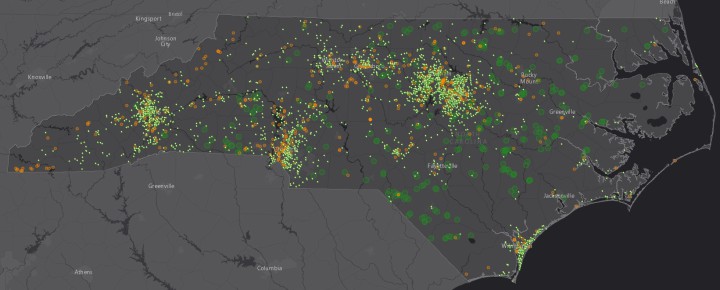North Carolina reached a milestone last year when its installed solar capacity exceeded 1 gigawatt, according to a clean-energy census by the N.C. Sustainable Energy Association. This feat makes North Carolina a national and regional leader in solar energy behind only California, Arizona and New Jersey.
The NCSEA census also noted that the Tar Heel solar industry employs 5,541 people and generated more than $1.8 billion in revenue in 2015, accounting for 20 percent of all North Carolina clean-energy firms and 21 percent of all clean-energy jobs.
That’s just one part of North Carolina’s growing clean-energy economy, which also includes biofuel, energy efficiency and wind power, and now totals nearly $7 billion in revenue and more than 26,000 jobs. Between 2014 and 2015, the state’s employment in this area increased 14 percent and revenues increased by 45 percent. Nearly $2.7 billion was invested in clean-energy development in the state in the period from 2007-13, according to a report by the research firm RTI International. State government supported those efforts to the tune of about $135 million.
“The clean-energy industry in North Carolina continues to prove its economic value to the state, steadily adding jobs and revenues,” said NCSEA’s manager of energy research, Robin Aldina, the author of the census.
Surpassing the 1-gigawatt threshold is “a great milestone,” said Dave Hollister, co-founder of Sundance Power Systems in Weaverville. “Solar has been a great boon to the state of North Carolina. It has seen rapid growth. We’ve built a very substantial industry in the state. We’ve created thousands of jobs.”
In a measure of how much the industry has grown over the past two decades, Hollister said he and his wife installed the state’s first net-metered solar-power system on their Madison County home in 1995.
“Net-metering is the process by which a house can interconnect solar [with] the utility grid, and it essentially allows that solar array to use the grid as temporary storage when it’s producing in excess of consumption,” Hollister said. “That’s been one of the key elements in the expansion of solar. Until that point, most of the systems were battery-based, off-grid systems. The adoption of net-metering in North Carolina was the first step in expanding solar resources in our state.”
Hollister believes demand for solar installations will remain strong on residential properties because they increase a home’s property value and salability.
“The numbers still work fairly well from a residential standpoint,” he said. “People are doing systems on their homes because they believe it’s the right thing to do. Most people want expansion of solar.
“The renewable energy future is the most inexpensive future we have in producing energy,” Hollister maintains. “Fossil fuel energy, including natural gas, is the expensive future for the state of North Carolina. Everybody sees the writing on the wall, whereas 20 years ago people did not see this.”
For more information, visit North Carolina Installed Solar Systems.
http://energyncmaps.org/gis/solar/index.html
[CAPTION] As of December 2015, there were approximately 1.214 gigawatts of solar PV energy systems powering North Carolina.
Map and Data compilation, North Carolina Sustainable Energy Association.
GRAPHICS: *Permissions needed




Before you comment
The comments section is here to provide a platform for civil dialogue on the issues we face together as a local community. Xpress is committed to offering this platform for all voices, but when the tone of the discussion gets nasty or strays off topic, we believe many people choose not to participate. Xpress editors are determined to moderate comments to ensure a constructive interchange is maintained. All comments judged not to be in keeping with the spirit of civil discourse will be removed and repeat violators will be banned. See here for our terms of service. Thank you for being part of this effort to promote respectful discussion.